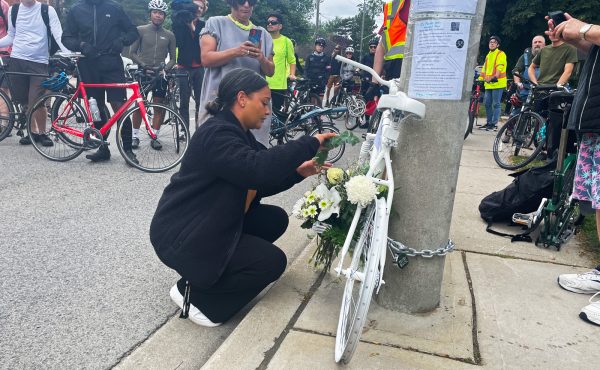One of the first actions Toronto’s new Mayor Olivia Chow took was to declare intimate partner violence and all forms of gender-based violence a city-wide epidemic.
She followed the path laid by the Renfrew County inquest into murders of Carol Culleton, Anastasia Kuzyk, and Nathalie Warmerdam. That inquest led to the declaration of an intimate partner violence epidemic in the region and sparked declarations of abuse epidemics in over 30 other Ontario municipalities. The inquest also triggered Canada’s new justice minister to write a response letter stating that gender-based violence is an epidemic that “has no place in our country”.
And all of these municipal declarations emerged after the United Nations named the rise of violence against women a shadow pandemic gripping the globe alongside the coronavirus.
In a sense, it’s not a new move for municipalities. City-level identification of and response to mass sickness is ancient.
The city has long existed as an ideal locus for measures to control epidemics. Medieval plagues prompted local controls like sanitary cordons and quarantine measures. Even where mass sicknesses may have been more or less attributed to moral failings, spiritual corruption, and divine punishment, practical efforts were taken to block and contain them in cities. In the modern era, hygiene practices, clean water and sewage infrastructure, and delivery of vaccination and antibiotics have been some of the key measures.
It’s within our contemporary era that behavioural epidemics like loneliness, suicide, disconnection, and overdose are problematized as never before.
Behaviour is, of course, always operative in the spread and severity of mass disease, and it goes both ways. The spread and severity of illness influences our behaviour as individuals and groups. In the thick of illness crisis, yes. But a shared experience of mass illness can also profoundly change the choices we make and expectations we carry about our lives.
This is the core spark of hope in the recent municipal declarations of gender-based violence epidemics: that naming the threat to health and wellbeing of a large swath of our communities will lead to the profound social and cultural change required to eliminate it.
At the same moment, there could be pitfalls inherent to framing abuse as disease. If it functions to drain accountability from abusers for their actions, it could stymie willingness to protect those who are victimized. It could reduce the agency of bystanders whose non-judgmental care and support abuse survivors need.
Another challenge to taking action to end epidemics of abuse is its very normalization. There’s nothing out-of-the-ordinary about widespread gendered violence like intimate partner abuse, family violence, and sexual assault and harassment.
We’ve been so inert partly because see it as a fact of life, as much as the misogyny and sexism that underlie it.
Forty-four per cent of women in Canada experience some form of emotional or physical abuse from a partner in their lifetimes. The number of women, girls, and Two Spirit, trans, and non-binary people who are targeted due to gender, live in fear of abuse, and are unsatisfied with their level of personal safety is higher, especially when they are marginalized.
And the number of people personally touched by this abuse in some way might encompass just about everybody.
What does it mean for municipalities to put a fine point on such a universal epidemic?
It means not everyone is on board with calling it an epidemic. The Province of Ontario has opted out of declaring intimate partner violence as such “as it is not an infectious or communicable disease.”
But communicability itself is a matter of interpretation. How is gendered abuse so perpetratable, so replicated, so learned and relearned across generations? Perhaps a rigorous epidemiologic lens on this violence and the trauma it creates can strengthen the case for regional policy reform and advocacy.
While municipalities might pin responsibility for solutions on higher levels of government, the most effective public health measures come from robust partnerships between municipalities, provinces and territories, and federal governments.
In declaring abuse epidemics, cities themselves must be prepared to take real action and make significant investment. They are effective sites of tracking and mitigation. It has been the case in historical epidemics, and it remains the reality now.
Prevention of and treatments for an epidemic of gender-based violence is not like water fluoridation or delivery of antibiotics and vaccines. Change has to be activated across multiple sites of everyday life and service provision. Rates of gendered abuse and its mental and physical health impacts will not meaningfully decrease with a narrow focus on police and prosecution.
No level of government is justified in declaring an abuse epidemic and going on to blame inaction on their tied hands. Nor is any level of government in the position to opt out of acknowledging the blight of gendered violence, the “longest, deadliest pandemic” around the world.
As complicated as it is, it is an utterly preventable pandemic. Solutions must conform to evidence with the goal of eradicating the problem.
And how would we know an abuse epidemic is over?
The functional end of an illness emergency is tricky to put a finger on. The end of the COVID-19 pandemic has been subject to debate, disagreement, and tough-to-resist pressures to treat the matter as if it’s over.
The end of a behavioural epidemic like gender-based violence may be similarly messy. But the least we should expect with effective responses is a downturn in victimization rates, both those measured by local police reports and those identified through personal report surveys.
The least we can do is ask diverse women, girls, and Two Spirit, trans, and non-binary people at highest risk in our cities if they’re less afraid of targeting and harm.
photo by Alex Guibord




